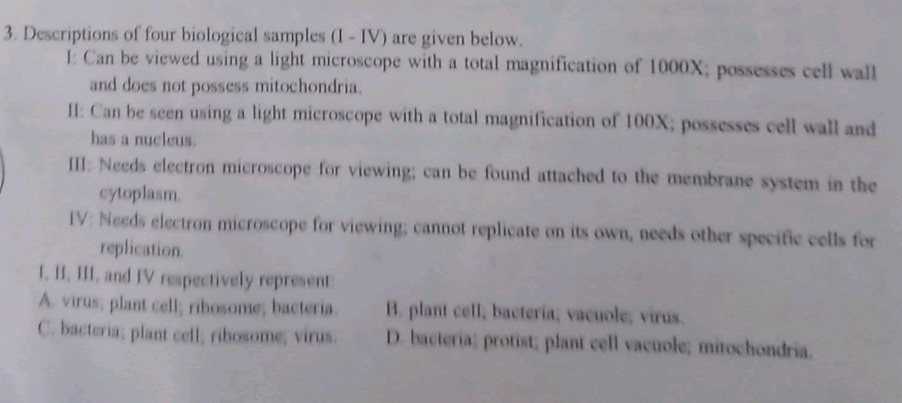Descriptions of four biological samples (I- IV) are given below. 1. Can be viewed using a light microscope with a total magnification of 1000X; possesses cell wall and does not possess mitochondria. II: Can be seen using a light microscope with a total magnification of 100X; possesses cell wall and has a nucleus. III: Needs electron microscope for viewing; can be found attached to the membrane system in the cytoplasm IV: Needs electron microscope for viewing, cannot replicate on its own, needs other specific cells for replication. 1. II, III, and IV repectively represent A virus, plant cell; ribosome; bacteria. C. bacteria, plant cell, ribosome, virus. B. plant cell, bacteria, vacuole, virus. D. bacteria; protist, plant cell vacuole, mitochondria.
Descriptions of four biological samples (I- IV) are given below. 1. Can be viewed using a light microscope with a total magnification of 1000X; possesses cell wall and does not possess mitochondria. II: Can be seen using a light microscope with a total magnification of 100X; possesses cell wall and has a nucleus. III: Needs electron microscope for viewing; can be found attached to the membrane system in the cytoplasm IV: Needs electron microscope for viewing, cannot replicate on its own, needs other specific cells for replication. 1. II, III, and IV repectively represent A virus, plant cell; ribosome; bacteria. C. bacteria, plant cell, ribosome, virus. B. plant cell, bacteria, vacuole, virus. D. bacteria; protist, plant cell vacuole, mitochondria.
Biology (MindTap Course List)
11th Edition
ISBN:9781337392938
Author:Eldra Solomon, Charles Martin, Diana W. Martin, Linda R. Berg
Publisher:Eldra Solomon, Charles Martin, Diana W. Martin, Linda R. Berg
Chapter4: Organization Of The Cell
Section: Chapter Questions
Problem 1TYU: Which of the following is the most fundamental feature that enables the cell to function as a...
Related questions
Question

Transcribed Image Text:3. Descriptions of four biological samples (I- IV) are given below.
1 Can be viewed using a light microscope with a total magnification of 1000X; possesses cell wall
and does not possess mitochondria.
I1: Can be seen using a light microscope with a total magnification of 100X; possesses cell wall and
has a nucleus.
III: Needs electron microscope for viewing; can be found attached to the membrane system in the
cytoplasm.
IV: Needs electron microscope for viewing, cannot replicate on its own, needs other specific cells for
replication.
1, II, III, and IV repectively represent
A virus, plant cell; ribosome, bacteria.
C. bacteria, plant cell, ribosome, virus.
B. plant cell, bacteria, vacuole, virus.
D. bacteria; protist, plant cell vacoole, mitochondria.
Expert Solution
This question has been solved!
Explore an expertly crafted, step-by-step solution for a thorough understanding of key concepts.
Step by step
Solved in 2 steps

Knowledge Booster
Learn more about
Need a deep-dive on the concept behind this application? Look no further. Learn more about this topic, biochemistry and related others by exploring similar questions and additional content below.Recommended textbooks for you

Biology (MindTap Course List)
Biology
ISBN:
9781337392938
Author:
Eldra Solomon, Charles Martin, Diana W. Martin, Linda R. Berg
Publisher:
Cengage Learning

Biology: The Dynamic Science (MindTap Course List)
Biology
ISBN:
9781305389892
Author:
Peter J. Russell, Paul E. Hertz, Beverly McMillan
Publisher:
Cengage Learning

Biology Today and Tomorrow without Physiology (Mi…
Biology
ISBN:
9781305117396
Author:
Cecie Starr, Christine Evers, Lisa Starr
Publisher:
Cengage Learning

Biology (MindTap Course List)
Biology
ISBN:
9781337392938
Author:
Eldra Solomon, Charles Martin, Diana W. Martin, Linda R. Berg
Publisher:
Cengage Learning

Biology: The Dynamic Science (MindTap Course List)
Biology
ISBN:
9781305389892
Author:
Peter J. Russell, Paul E. Hertz, Beverly McMillan
Publisher:
Cengage Learning

Biology Today and Tomorrow without Physiology (Mi…
Biology
ISBN:
9781305117396
Author:
Cecie Starr, Christine Evers, Lisa Starr
Publisher:
Cengage Learning
